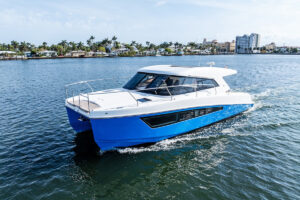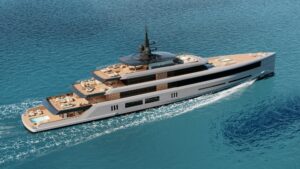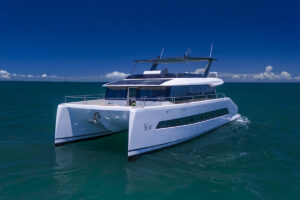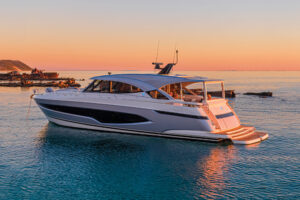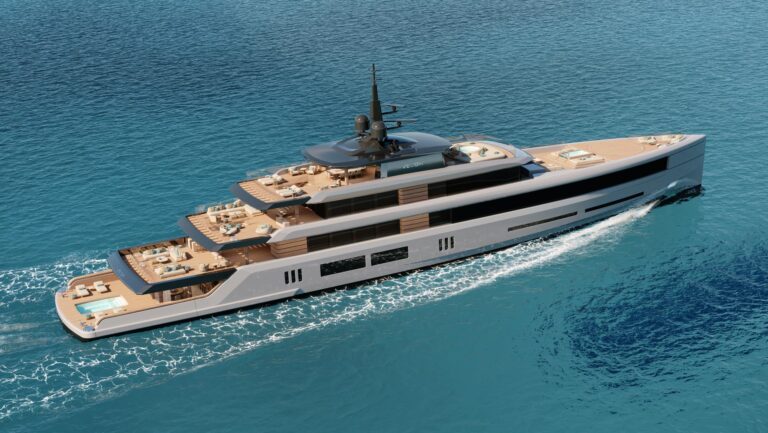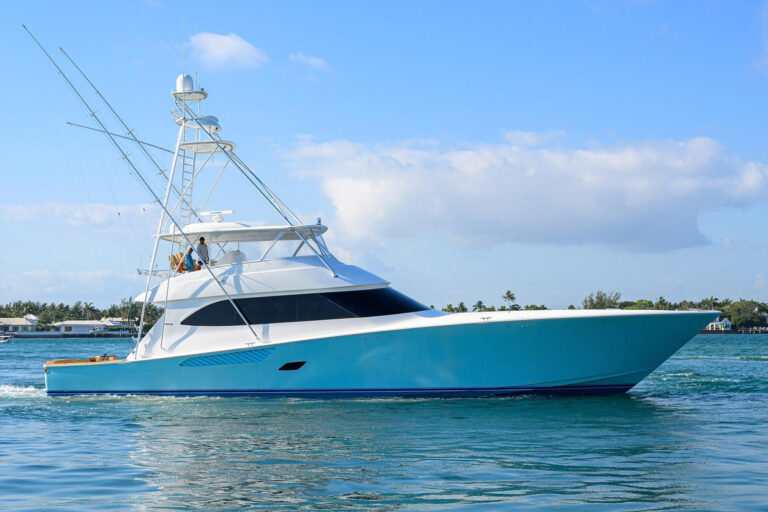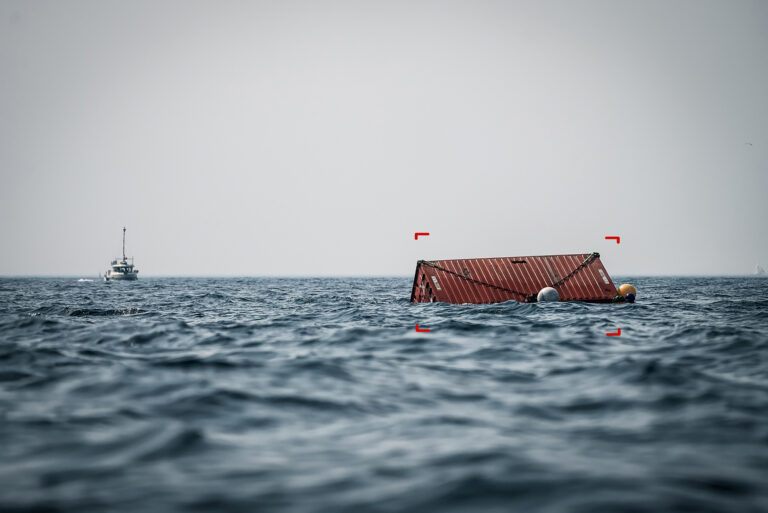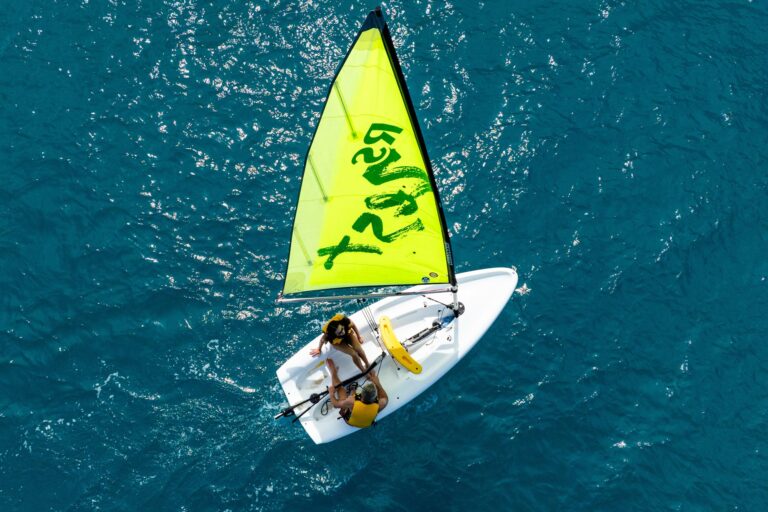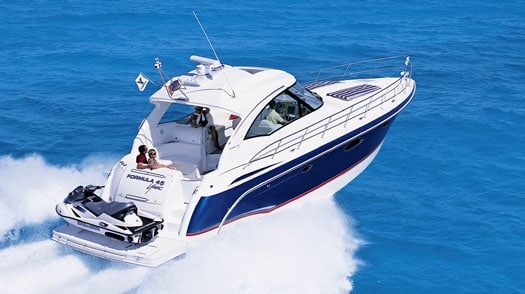
yachting/images/magazine/2006/072006/fea_formula_525x294.jpg
Looking westward from Sarasota’s New Inlet, the Gulf of Mexico was a seamless cyclorama where shrimp boats seemed to rise above the sea in shimmering fata morgana. It was a Monday morning and the frenzy of weekend boaters had vanished and the Gulf seemed relaxed-or was it exhausted? For Formula’s Vic Spellberg and me, it didn’t matter. We were off on an anticipated odyssey that would take us, over the next few days, from Florida’s west coast to the east coast via its soggy, fertile middle-familiar ground for both of us, but no less exciting.
We turned south, put the new Formula 45 yacht on autopilot, slid back the sunroof and dreamed of “one particular harbor,” as Mr. Buffett sings, watching the depth varying little from 36 feet, our speed a constant 31.2 mph. I had to ransack my memory to recall the last time I’d seen the Gulf this quiescent.
The 45’s bridge already had proved to be the ideal platform for inveterate voyeurs and connoisseurs of the passing scenery, including myself. This fully enclosed sweep of windows in a permanent hardtop is a configuration Formula calls its “coupé.” For anyone seated on the portside bench, or especially the double helm/companion seat opposite, it affords unobstructed views of the world around you and, not so incidentally, for the helmsman of the bow and stern.
It is a very comfortable arrangement with a party center replete with electric grill, icemaker/fridge, sink, stowage for trash and an auxiliary Igloo abaft this. An isinglass curtain drops down behind to seal off the 30,000 BTUs of cockpit air-conditioning, if you like. At 90°F ambient, we liked. We were snug in a temperate world of our own.
Our transit took us well offshore of some of Florida’s most glorious beaches on islands as thin as razor clams. From here they were like tufted sandbars with houses tucked into the casuarina and pine, windows winking friendly semaphores. Now and again, we glimpsed the Spanish Revivalism popularized in the east by architect Addison Mizner in Palm Beach and developer George Merrick in Coral Gables. Occasionally, there was an eruptive highrise, but for the most part it was not too unlike the landscape first discovered by the overanxious 16th-century Spaniards.
North of here, Pánfilo de Naváez found himself ingesting more of the Gulf than he wanted as he fled the supremely irritated Apalachee Indians. Just over there, in Charlotte Harbor, the conqueror of Hispaniola and Puerto Rico and the discoverer of La Florida (1513), Juan Poncé de León, tripped not over the Fountain of Youth but a Tocobaga arrow and fell mortally wounded.
And out in the middle of this great limestone peninsula, Hernando de Soto thrashed his way through slash pine and saw palmetto looking fruitlessly for gold (apparently geology wasn’t the Spaniards’ strong suit) before turning north into Georgia and South Carolina, thence westward, eventually dying on the banks of the Mississippi.
We, on the other hand, were doing just fine. At 3:15 that afternoon, we rounded Sanibel Light-well to the south to avoid the sprawling shoals that keep TowBoatUS fat and happy-transited San Carlos Bay, threaded our way through Miserable Mile, the notorious stretch of no-wake leading into the Caloosahatchie River, and eased into the Fort Myers Yacht Basin for fuel.
This charming old town did indeed begin life as a fort, built in 1850 and named for Col. Abraham Myers, a South Carolinian who later became quartermaster general of the Confederate army. It was a genuine backwater until Thomas Alva Edison built a compound with house and laboratory here to escape New Jersey winters. Eventually, his friend Henry Ford built a home nearby. The two magnates quickly became magnets for others.
Edison’s sprawling Seminole Lodge notwithstanding, I’d begun to appreciate the ingenuity of Formula’s design and execution (courtesy of the redoubtable John Adams). This may well be the company’s most fully found yacht to date.
Beyond the bridge’s weather barrier are the open cockpit and other benches and the transom door. The swim platform is as wide as a platypus’ bill and is hydraulically controlled. Put your PWC or dink on it, lower same into the water and float it off. Retrieval is equally easy. Behind the portside bench, there is an ingenious stowage space for curtains and such.
Below stairs, as the Brits say, the accommodation is as well-thought-out as you’ll find in a 45-foot yacht. The master is forward, a high-pedestal queen with steps up both sides, stowage under and hanging lockers port and starboard, a large hatch over (plus two portlights), shelves running down both sides (but needing fiddles), and a really nice arrangement with head and shower in separate compartments, both very large and comfortable.
The after stateroom is smaller, but cleverly laid out with twin berths to starboard, converting to a double with an ingenious flip-out filler. The sink is en suite, and the head and shower are in a separate compartment.
The saloon is amidships, with lots of stowage in ubiquitous cabinets; a hi-low dinette table on the starboard side is roomy enough, as we Americans say, for six Krispy Kreme derrières and the banquette is upholstered in Ultraleather. Ralph Lauren fabrics are optional.
The galley opposite has a stand-up fridge/freezer, two-burner electric range (the Corian cover flips up to double as a splash board) and a microwave. Again, tons of stowage. There also is a translucent panel over the galley, in addition to large oval portlights. A handsome teak and holly sole plays off of the rich cherry laminates.
Three large flat-screen TVs provide the indoor entertainment. The one in the after stateroom is battery-powered and may be relocated to a special bracket on the bridge.
Line-handling is easy, even if the side decks are too narrow for my large green Crocs. Fortunately, the forward windshield is split by a fold-back door, giving easy access to the foredeck with its two-person sunpads.
Unfortunately, I was unable to fully test the facilities-other than the heads-as this was hull No. 1 and Formula was keeping it as a showboat. (If you’re interested, take a number; they’re sold out into next year.) So, after overnighting in the Winyah Bay motel adjacent to Centennial Marina, we churned out into the Caloosahatchee current, already chocolaty brown and subsuming the azure Gulf.
Our immediate problem was a dense ground fog hugging the river and reducing visibility to less than 30 yards, the sun fading to a hot white disk. Power yachts and sailboats suddenly emerged, their captains looking like ghosts of spooked skippers past, wide-eyed and apprehensive at our approach.
An hour later, after we advanced cautiously with the aid of the Raymarine electronics package (love the new chart plotter with the aerial views), the sun finally burned off the mist and we could smell the hot scent of the jungle. We were now in the Caloosahatchee Canal, a.k.a. the Okeechobee Waterway, approaching the headwaters of what was once a boisterous river replete with rapids.
Our first lift was a three-foot rise in the W.P. Franklin Lock at Olga. Not long after passing the Fort Denaud Bridge with its gracious lady bridge tender, we glided by the two-century old town of La Belle, home of the Swamp Cabbage Festival every February. This delicacy is sold in fancy restaurants as hearts of palm.
Then it was the Ortona Lock and, the last before entering the lake, the Moore Haven Lock. It was here, on September 18, 1926, that a hurricane plowed into Miami, drove straight across Lake Okeechobee and collapsed the western rim, drowning 300 souls, injuring 6,000 and leaving 18,000 homeless. Two years later, on September 16, another major storm ripped Palm Beach apart before engulfing Okeechobee and killing an estimated 2,000. A more recent tempest left a trail of destruction, with pieces of mobile homes still littering the banks.
We transited the rim canal, running through the majestic drowned forest, and made the sugar town of Clewiston and Roland and Mary Ann Martin’s Marina at 1:30, just in time to lunch on their famous Bubba Burger. It fit right in with the tiki décor and the man whose t-shirt read Take Only Trophies/Leave Only Gut Piles.
Prior to entering Lake Okeechobee, we’d been traversing mostly cane fields and the heavy scent of sugar being refined hung over the river. Now, in the St. Lucie Canal, we were enveloped in the heavenly perfume of orange blossoms.
And the waterway changed rapidly as we now went downhill. Development is rampant, but the thickly mantled islets, known as river ayots, persist, remnants of pre-history. The St. Lucie Lock was a breeze, the railroad bridge under the Roosevelt Bridge interminable.
The next morning, we picked up two more passengers, Bob Schneider and Jill Davis. Bob and I had shared another adventure a few years back when, along with Formula’s Scott Porter and Yachting’s Peter Janssen, we crossed the Gulf Stream from Key West to Mariel in Cuba.
This day, we ran briefly down the outside (the Atlantic was as much of a mill pond as the Gulf had been), ducked into Boynton Beach for lunch, then took a real estate tour down The Ditch to Ft. Lauderdale. The McMansions were glittering, and the beautiful people ashore probably would have convinced Poncé de Léon the Fountain of Youth wasn’t so far off.
Our bright, calm weather had been a blessing to us, and while posing no great test of the Formula’s hull, it affirmed her place as an absolutely first-rate cruiser for such a luxurious journey-just the ticket to paradise.
Thunderbird Products, (260) 724-9111; www.formulaboats.com

